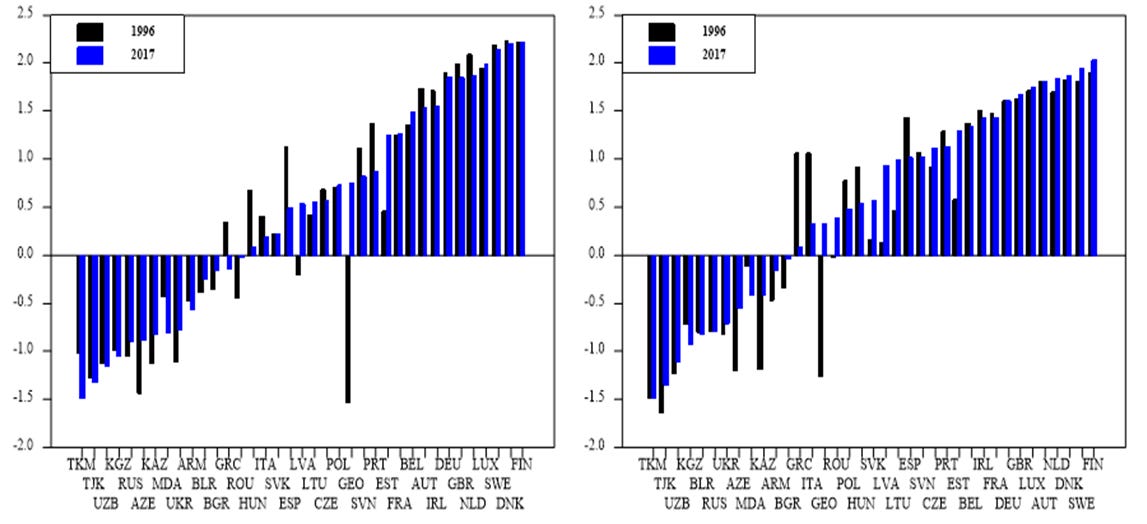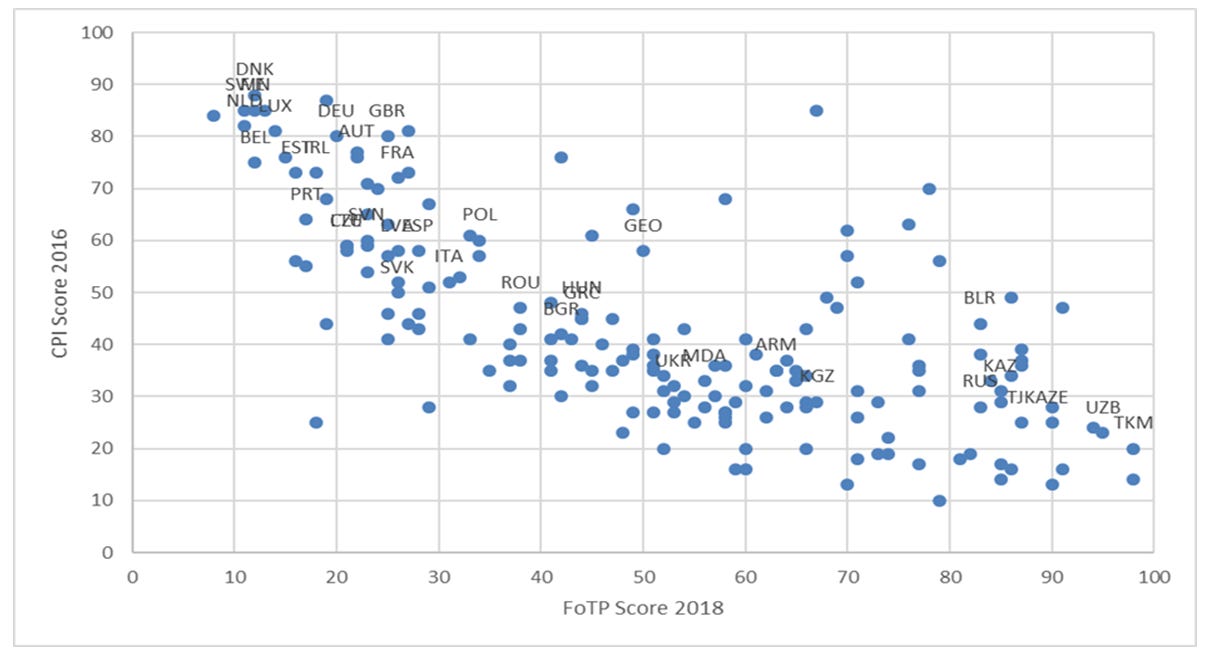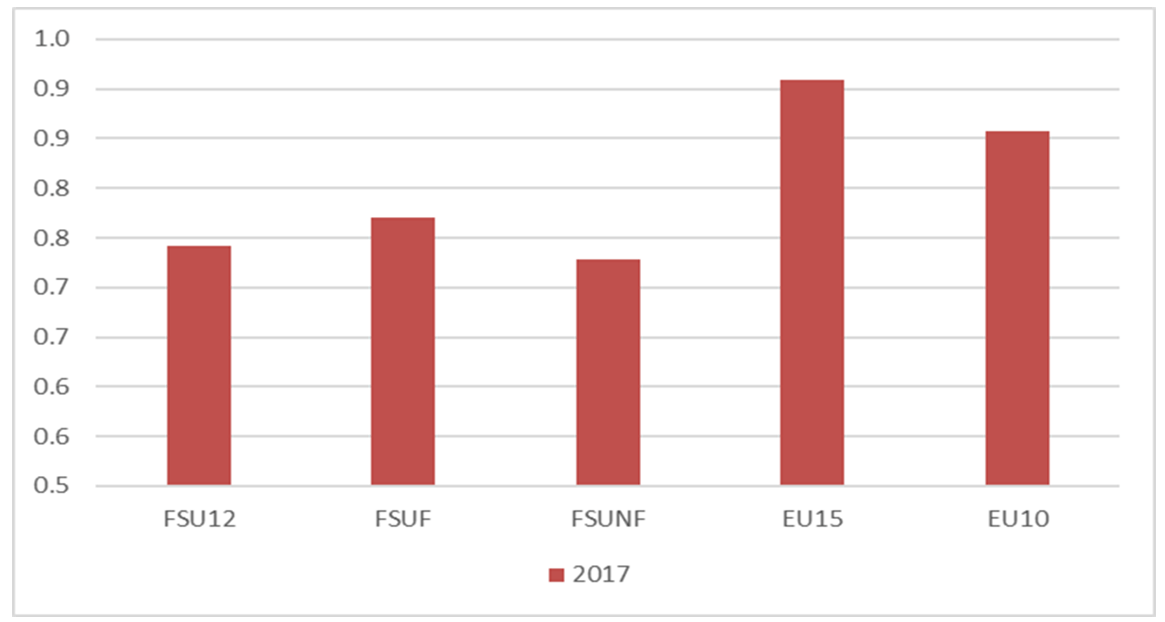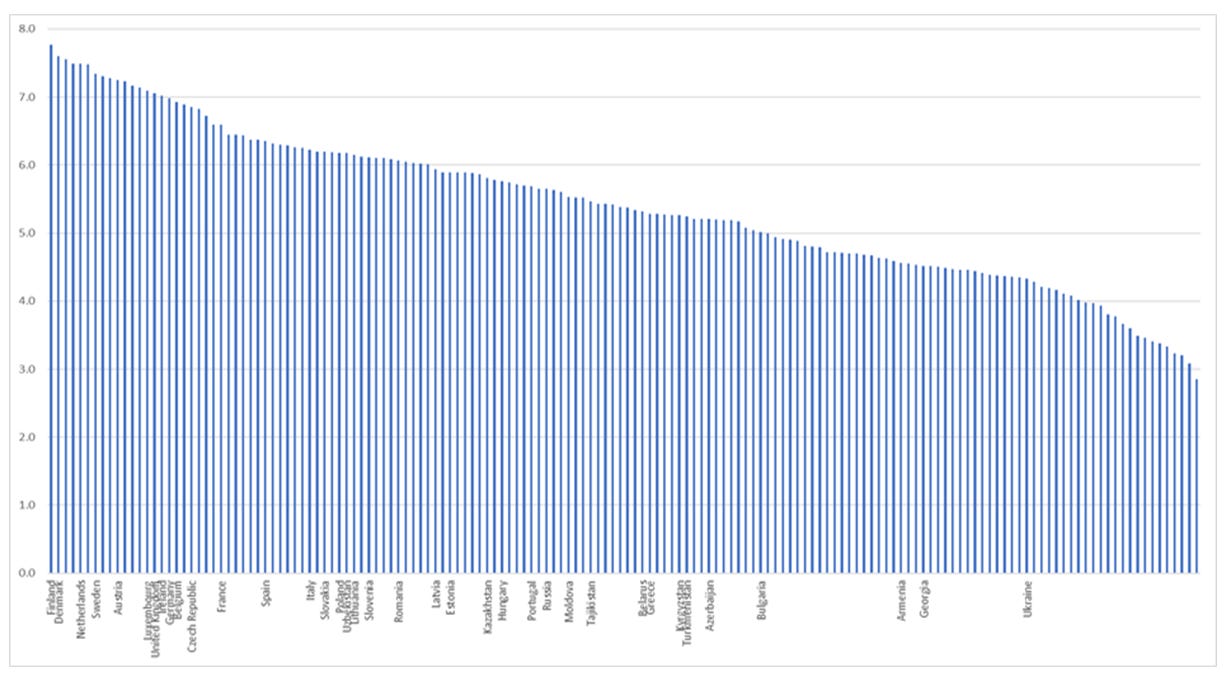Why the EU really matters
Spoilers. The EU is a success with the perhaps most obvious example being the Single Market which has led to increasing living standards in the EU. But the most important reason for people from the Baltics and Eastern European Countries to join the EU were the EU values of respect for freedom, democracy and human rights. But the EU is not perfect. Once inside the EU, governments with autocratic ambitions as Orban's Hungary can demount their citizens rights and violate EU fundamental values.
The EU Single Market is a success...
The most obvious success of the EU is of course the Single Market which has had a significant positive impact on GDP and welfare for EU citizens, see here for one of many reviews. Caused primarily by the free movement of goods and capital, trade and investment flows have increased significantly which is reflected in stronger competition on markets, more innovation and product varieties at lower prices compared to a situation with trade barriers.
... but what really matters is citizens’ rights...
But what really matters is stated in Article 2 in the Treaty of the European Union:
“The Union is founded on the values of respect for human dignity, freedom, democracy, equality, the rule of law and respect for human rights, including the rights of persons belonging to minorities. These values are common to the Member States in a society in which pluralism, non-discrimination, tolerance, justice, solidarity and equality between women and men prevail.”
This is attractive for people in other countries with autocratic governments. The Maidan revolution in Ukraine showed that its people want to live in open democratic and societies governed by the Rule of Law instead of a in country run by a corrupt president who distributed the wealth and benefits among fellow oligarchs. This model was not unique for Ukraine but has prevailed until this day in most of the former Soviet Union republics especially in Russia which is shown here.
...which made people in Eastern European countries willing to join the EU
Three exceptions from this rule are provided by Estonia, Latvia and Lithuania which have shown that choosing the EU, or Western model of society, is beneficial for well-being in many ways. The Baltics have become open, free and transparent countries where people have more incentives to invest in education and productive activities compared to most other former Soviet Union republics where corrupt bureaucracies and judicial systems make investments risky.
In this post I compare the effects of the two different choices of social model on the lives for ordinary people with the aid of indicators. Since this will involve many countries, I must make it manageable by grouping countries some way. I will use the same groups as Becker and Olofsgård (2017): EU15 which consists of the member states comprising EU until 2004, EU10 which consists of the Baltics and Eastern European countries which joined the EU in 2004 and 2007, FSU12 which includes twelve former Soviet Union Republics. FSU12 is split in two groups, FSUF, where F stands for fuel dependent and FSUNF where NF stands for Non-Fuel dependent.[1]
All such groupings can be criticized for many reasons. Adding Bulgaria and Romania to the other Eastern European countries is questionable as the latter had already reformed their countries as they adopted the acquis communitaire earlier. The acquis is a full and exhaustive agenda of legal, institutional and economic reforms.[2]
Many of the chapters in the acquis concern the functioning of the Single Market but especially important is chapter 23 “Judiciary and fundamental rights” which states that EU member states are forced to guarantee its citizens fundamental rights as guaranteed by the EU Fundamental Rights Charter. The chapter also spells out the member states’ obligations to respect the principles of an independent and impartial judiciary system ensuring a Rule of Law and fight corruption.
The Baltics and eastern European countries have outgrown other FSU countries outside the EU...
Comparing GDP per capita developments since 1990, show that EU10 has outgrown the other groups. Annual average growth amounted to some 2.8 percent. In 1990 EU10 GDP per capita only amounted to around 2/3’s of FSUF GDP per capita but in 2017 the ratio had changed to 1.10. It would probably have been higher had not the FSUF benefitted strongly from the increase in oil prices that began in 1999. The inability of FSUNF to recover to its 1990 level depends to a large extent on the poor economic developments in Ukraine whose people have been cursed by oligarchs and Russian troops, c.f. Figure 1.
Figure 1. GDP per capita developments 1990-2017.
Source: World Bank Database. https://databank.worldbank.org/data/source/world-development-indicators# Note: All series are shown as logs of an index, which equals 1.0 at 1990 so the series start at zero. Since the vertical axis is in log units, the slopes of the series are the rates of growth. An increase of 0.1 is a growth of 100*(exp(0.1)-1). As an example, FSUNF GDP had decreased by some -0.75 in 1996 which corresponds to a 100*exp(-0.75)-1) = -52.7%. Log changes are approximations.
Figure 1 offers some more interesting observations. Following the breakdown of the communist rule, EU10 reached its bottom level after two years and recovered to its 1990 level after six years, much faster than in FSU countries. The initial decline, from 1990 to “bottom”, was also lower. The fact that EU10 were impacted less severely and recovered much quicker shows that their economies already then were more flexible than FSU countries.[3]
…and the people in the new EU countries are freer than people in the FSU countries...
Economic developments and other aspects of well-being such as freedom of expression and other civil liberties and political rights are not independent of each other. Many studies have confirmed that economic and political institutions that characterize liberal democracies are beneficial for prosperity. The immediate effects of the breakdown of communist regimes in the end of 1980’s and in the beginning of the 1990’s was freedom for the citizens that were forced to live under those regimes. In 1990, Freedom House classified these countries as Partly Free. Even though governments in many of these countries implemented reforms that increased people’s freedom, some regimes found it to be in their interests to make their citizens less free, c.f. Table 1.
Table 1. Freedom in the EU and FSUF 1990 and 2018.
Source: Freedom House. https://freedomhouse.org/report/freedom-world/freedom-world-2018
The reversal went especially fast in FSUF countries, with Azerbaijan and Turkmenistan being classified as Not Free already after some years in the 1990’s. Kazakhstan and Russia, after the installation of Putin, gradually imposed restrictions that turned these countries to Not Free in the first half of the 2000’s. Also, some FSUNF countries are classified as Not Free; Belarus, Tajikistan and Uzbekistan.
While Belarus and Russia turned Not Free, Estonia implemented key reforms very soon after its independence.[6] The reforms were made with a EU membership in mind. In the FSUF and FSUNF countries Belarus and Russia, the situation has steadily deteriorated after a few initial years of improvement. The installation of Putin as president in Russia had a significant effect on the pace of deterioration of freedom in Russia, c.f. Figure 2.
Figure 2. Indicators of freedom and democracy in Belarus, Estonia and Russia.
Source: Varieties of Democracy (V-Dem). https://www.v-dem.net/en/
There is a wealth of literature exploring the relationships between economic and political institutions on one hand and economic growth and living standards on the other hand.[4] The World Bank has done extensive work in this area. Part of that work is reflected in its Worldwide Governance Indicators (WGI). These are indicators of the quality of economic and political institutions and respect of citizens.[5]
…and also the judicial system is less partial and more difficult to bribe than in FSU countries…
The WGI are highly correlated so I will only mention two below; Control of Corruption and Rule of Law. As you can see in Figure A.2. in the appendix, these two indicators are positively correlated with GDP per capita. The EU10 were already in 1996 less corrupt and to a higher extent characterised by Rule of Law than FSU countries, especially the FSUF countries which appear as the worst in these respects, c.f. Figure 3.
Figure 3. Control of corruption and Rule of Law 1996 and 2017.
Source: World Bank Database. https://databank.worldbank.org/data/source/worldwide-governance-indicators# Note: The range of the indicators are -2.5 to 2.5.
The indicators in Table 1 and Figures 2 and 3 are of course not independent of each other. For example, is corruption much higher in countries where the Freedom of the Press is restricted. In most FSU, and especially FSUF countries is the press strictly controlled by the regimes allowing them to distribute wealth and revenues from for example infrastructure projects among the people close to the power centres. Even though far from perfect, as free press has reported about Romania, in EU countries the press is less restricted, and the control of corruption is stronger, c.f. Figure 4.
…where the regimes restrict the media which makes it more difficult to expose corruption…
Figure 4. Freedom of the Press and Corruption.
Source: Transparency International, https://www.transparency.org/cpi2018 and Freedom House, https://freedomhouse.org/report-types/freedom-press Note: CPI is Corruption Perceptions Index and FoTP is Freedom of The Press.
There are also other indicators that aim to gauge welfare and well-being in different countries. United Nations have developed the Human Development Index (HDI). The HDI was created to emphasize that other factors than economic growth should be used to assess countries’ developments. The HDI also takes educational attainment and life expectancy into account yielding an indicator that measure countries’ achievements in providing citizens with long and healthy lives, proper educations and reasonable living standards.
…and altogether people in the EU are more prosperous, live longer and are better educated…
Taking also these aspects of quality of life into account, the EU appears to be a better place to live in than in FSU countries, c.f. Figure 5.
Figure 5. The Human Development Index 2017.
Source: United Nations Development Programme, http://hdr.undp.org/en/content/human-development-index-hdi
As mentioned above, one of the dimensions in the HDI is life expectancy at birth. The collapse of the communist regimes had devastating effects on people in those countries. Life expectancy at birth fell in the first years in the EU10 countries but then reversed due to policies aiming at integrating with the EU. In FSU countries, the gap vs EU15 is still larger than in 1990, c.f. Figure 6.
Figure 6. Differences in life expectancy in years to EU15 for the total population (left panel) and for men (right panel)1990-2017.
Source: World Bank Database. https://databank.worldbank.org/data/source/world-development-indicators#
…which might explain why people in the EU in general is happier…
That life is healthier, longer and richer in the EU than in FSU countries is confirmed by the Happiness Project. The surveys show how happy citizens in different countries perceive themselves to be. All in all EU citizens are happier than FSU citizens, c.f. Figure 7.
Figure 7. Happiness in the world.
Source: The World Happiness Report 2019. https://worldhappiness.report/
But once in the EU, governments can breach its fundamental values…
Having established that the EU offers a more attractive model for people than the FSU is not the same thing as claiming that the EU is perfect as witnessed by large demonstrations in the Czech Republic and Romania against corrupt members of governments. While corruption at these high levels of governments in EU countries may be viewed as signs of failures, the fact that these demonstrations could be organised and carried out, is a manifestation of the fundamental rights that are guaranteed within the EU. Demonstrations like these are forbidden and clamped down on in most FSU countries, especially in Russia.
There are other setbacks in the EU. The Hungarian governments actions to limit the freedom of the press, academia and independence of Hungary’s judiciary system is reflected in Freedom House’s latest assessment. Hungary is now regarded as Partly Free. And political scientists working in the V-Dem Project at the University of Gothenburg reach the same conclusion:
“Orban’s actions have led to restrictions in Hungary’s judiciary. Judges opposing the regime have been forced out and replaced with judges loyal to Orban and Fidesz. At the same time, opposition parties’ ability to challenge the regime have been hindered by Fidesz’s increased control of the media. The regime’s control of state resources has also starved opposition parties of campaigning opportunities. Finally, Orban has used unfair elections to establish himself in office and consolidate his political power.”
Also Poland is in the limelight after the government’s attacks on the independency of the country’s judiciary and attempts to gain partisan influence over the selection of election committee members. The autocratization of these and other countries is analysed in more detail here.
…which is why the Treaty should be revised in order to better protect EU citizens against its governments
Unfortunately, governments that have violated EU’s fundamental values, can get away with it the European Council fails to gather the necessary support for an Article 7 decision .
During some time now, the values of the EU have been under attack from especially the Hungarian prime minister who wants to establish an “illiberal democracy”. He and other “populists” on the left and right claim that the EU is threatening national self-determination. But the EU is not a union for governments, it is a union for people. Individuals have rights, not governments. Since the prevailing Treaty of the European Union does not provide enough protection of EU citizens against its governments, the treaty should be revised aiming to prevent governments who breach EU’s fundamental rights to form blocking minorities in Article 7 decisions.
Read more.
Acemoglu, D. and Robinson, J.A. (2012). “Why Nations Fail. The Origins of Power, Prosperity and Poverty”. Crown Publishing Group. New York.
Becker, T. and Olofsgård, A. (2017). “From Abnormal to Normal – two tales of growth from 20 years of transition.” HHS, SITE, working paper no 43.
European Commission. “Consolidated versions of the Treaty on the European Union and the Treaty on the functioning of the European Union. https://eur-lex.europa.eu/legal-content/EN/TXT/?uri=CELEX%3A12012M%2FTXT
European Parliament (2019). “The Internal Market: General Principles” Fact sheets on the European Union. http://www.europarl.europa.eu/ftu/pdf/en/FTU_2.1.1.pdf
Freedom House (2017) “Freedom of the Press 2017”. https://freedomhouse.org/report/freedom-press/freedom-press-2017
Freedom House (2018) “Freedom on the Net 2018”. https://freedomhouse.org/report/freedom-net/freedom-net-2018/rise-digital-authoritarianism
Freedom House (2019). “Freedom in the World 2019”. https://freedomhouse.org/report/freedom-world/freedom-world-2019/democracy-in-retreat
Transparency International (2019). “Corruption Perceptions Index 2018”. https://www.transparency.org/whatwedo/publication/corruption_perceptions_index_2018
V-Dem Institute (2019). "Democracy facing global challenges. V-Dem annual Democracy Report 2019. Department of Political Science, University of Gothenburg.
World Bank (2019). “Worldwide Governance Indicators”. https://info.worldbank.org/governance/wgi/#home
Åslund, A. (2015). “The Baltic Tigers: Past, Present and Future. Why Have The Baltic Tigers Been So Successful? “. CESifo Forum 4/2015 (December)
Appendix
Country groups
EU15: member states until 2004.
EU10: the Baltics and Eastern European countries which joined the EU in 2004 and 2007.
FSU12: twelve former Soviet Union Republics; Armenia, Azerbaijan, Belarus, Georgia, Kazakhstan, Kirgizstan, Moldova, Russia, Tajikistan, Turkmenistan, Ukraine and Uzbekistan.
FSU12 is split in two groups, FSUF, where F stands for Fuel dependent: Azerbaijan, Kazakhstan, Russia and Turkmenistan. FSUNF contains the other eight Non-Fuel dependent countries.
Figure A.1. Control of corruption (left panel) and Rule of Law (right panel) vs GDP per capita. Averages 1996-2017.
Source: World Bank Database. https://databank.worldbank.org/data/source/world-development-indicators# (GDP) and https://databank.worldbank.org/data/source/worldwide-governance-indicators# (Control of Corruption, Rule of Law). Note: The indicators of Control of Corruption and Rule of Law range from -2.5 to 2.5.
[1] As some of these Non-Fuel dependent countries are/were closely tied to the Russian economy, “NF” should be thought of as not directly dependent on fuel prices. Croatia is left out below since it did not join the EU until 2013.
[2] It should be noted that former Eastern European countries “approached” the EU already in 1991 when “Europe Agreements” were signed between them and the EU. These agreements reduced most of the then existing trade barriers between the countries and the EU. Accession negotiations began in 1997 and 1999.
[3] Much of this is likely the consequence of faster and more comprehensive reforms in these countries. There is a wealth of literature analysing different reform policies and their effects in the transition countries.
[4] One prominent example of this literature is Acemoglu and Robinson (2012) “Why Nations Fail”.
[5] ”Governance consists of the traditions and institutions by which authority in a country is exercised. This includes the process by which governments are selected, monitored and replaced; the capacity of the government to effectively formulate and implement sound policies; and the respect of citizens and the state for the institutions that govern economic and social interactions among them.” https://info.worldbank.org/governance/wgi/#home
[6] https://www.ifo.de/DocDL/forum-2015-4-aslund-baltic-tiger-december.pdf












